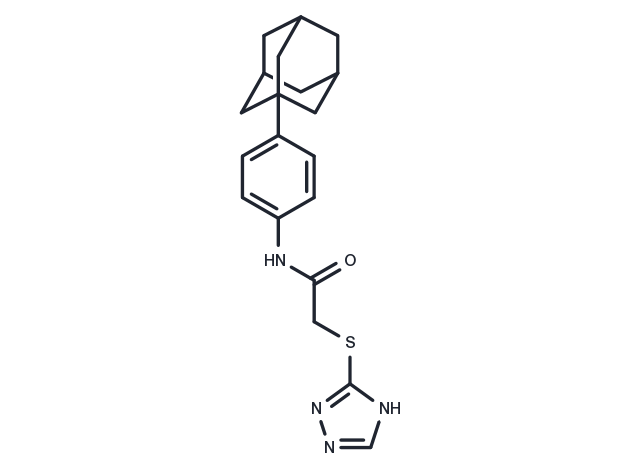Powder: -20°C for 3 years | In solvent: -80°C for 1 year


MGH-CP1 is a potent and selective inhibitor TEAD palmitoylation. It exhibits dose-dependent and potent inhibition of TEAD2/4 auto-palmitoylation in vitro with IC50 of 710 nM and 672 nM, respectively.

| Pack Size | Availability | Price/USD | Quantity |
|---|---|---|---|
| 2 mg | In stock | $ 34.00 | |
| 5 mg | In stock | $ 55.00 | |
| 10 mg | In stock | $ 89.00 | |
| 25 mg | In stock | $ 197.00 | |
| 50 mg | In stock | $ 347.00 | |
| 100 mg | In stock | $ 563.00 | |
| 500 mg | In stock | $ 1,180.00 | |
| 1 mL * 10 mM (in DMSO) | In stock | $ 87.00 |


| Description | MGH-CP1 is a potent and selective inhibitor TEAD palmitoylation. It exhibits dose-dependent and potent inhibition of TEAD2/4 auto-palmitoylation in vitro with IC50 of 710 nM and 672 nM, respectively. |
| Targets&IC50 | TEAD2:672 nM, TEAD4:710 nM |
| In vitro | MGH-CP1 exhibits dose-dependent and potent inhibition of TEAD2/4 auto-palmitoylation in vitro, with IC50 of 710 nM and 672 nM, respectively.?Furthermore, ?MGH-CP1 treatment markedly decreased the palmitoylation levels of endogenous or ectopically expressed TEAD proteins in cells. |
| In vivo | MGH-CP1 inhibits TEAD activity in Lats1/2 KO intestine in vivo. MGH-CP1 can effectively inhibit the palmitoylation of TEAD proteins in the intestinal epithelium. MGH-CP1 is well tolerated and has no apparent adverse effect on overall animal health or body weight after 2 weeks of treatment. In contrast to its lack of apparent effect in wild-type intestine, MGH-CP1 treatment effectively inhibits upregulation of the TEAD target genes, CTGF and ANKRD1, in Lats1/2 KO intestine |
| Cell Research | HEK293T cells, Lats1/2 conditional MEFs and MDA-MB-231 cells were cultured in DMEM supplemented with 10% FBS and 1% penicillin/streptomycin.?For Lats1/2 conditional MEFs carrying CMV-CreER, Lats1/2 was deleted by incubation with 4-OH Tamoxifen (2.5 mM) in DMEM for 4 days prior to further experiment.?Transfection in HEK293T cells was performed using Lipofectamine 2000 (Invitrogen).?For luciferase reporter assays, HEK293T cells were transfected with the luciferase reporter constructs TBS-Luc (8XGTIIC-Luc), Super TOP-FLASH (STF), Gli-BS-Luc, BRE-Luc, and NF-kB-Luc, as well as the expression vectors of pGIPZ-YAP5SA, pGIPZ-YAP6SA, pGIPZ-TAZ4SA, pLV-β-Catenin-ΔN90, pCIG-Wnt3a, pCMV-LRP5C, pCIG-BMP4, pCIG-Gli1,?pGIPZ-IKBKE (Rajurkar et al., 2017) and pCMV-Renilla lucifease.?Luciferase activities were conducted 24 hours after transfection using the dual-luciferase reporter kit (Promega) in the cells treated with or without Wnt3A, LiCl or MGH-CP1.?Assays were conducted in triplicates and quantified using PerkinElmer EnVision plate reader. |
| Molecular Weight | 368.5 |
| Formula | C20H24N4OS |
| CAS No. | 896657-58-2 |
Powder: -20°C for 3 years | In solvent: -80°C for 1 year
Ethanol: 74 mg/mL (200.81 mM)
DMSO: 74 mg/mL (200.81 mM)
You can also refer to dose conversion for different animals. More
bottom
Please see Inhibitor Handling Instructions for more frequently ask questions. Topics include: how to prepare stock solutions, how to store products, and cautions on cell-based assays & animal experiments, etc.
MGH-CP1 896657-58-2 Others MGH CP1 Lats1/2 deletion Myc MGHCP1 TEAD auto-palmitoylation Apoptosis Epithelial inhibit Inhibitor MGH-CP-1 inhibitor
